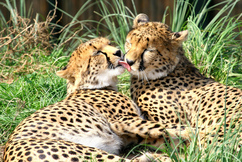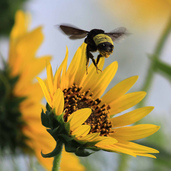- Welcome/Overview
- Content Notes
- Lesson and Activities
- Lesson 1-Living Systems-Where do we fit?
- Lesson 2- Explore Your "Wild" World!>
- Lesson 3- Building Food Chains and Food Webs>
- Lesson 4- Owls- A Mighty Predator
- Lesson 5- About Ecosystems>
- Lesson 6- We Are Explorers! (day1 of 2 lessons)>
- Lesson 7- We Are Explorers (day 2 of 2 lessons)
- Lesson 8-A Closer Look at Communities
- Lesson 9- What's in the Water?
- Lesson 10- Our Environment/Our World>
- Websites for Kids
- Books Used Throughout Lessons 1-10
- Assessment Page
Standard 3.5
The student will investigate and understand relationships among organisms in aquatic and terrestrial food chains. Key concepts include
a) producer, consumer, decomposer;
b) herbivore, carnivore, omnivore; and
c) predator and prey.
In order to meet this standard, it is expected that students will
· differentiate between predators and prey.
· distinguish among producers, consumers, herbivores, omnivores, carnivores, and decomposers.
· infer that most food chains begin with a green plant.
· identify sequences of feeding relationships in a food chain.
· explain how a change in one part of a food chain might affect the rest of the food chain.
· create and interpret a model of a food chain showing producers and consumers.
a) producer, consumer, decomposer;
b) herbivore, carnivore, omnivore; and
c) predator and prey.
In order to meet this standard, it is expected that students will
· differentiate between predators and prey.
· distinguish among producers, consumers, herbivores, omnivores, carnivores, and decomposers.
· infer that most food chains begin with a green plant.
· identify sequences of feeding relationships in a food chain.
· explain how a change in one part of a food chain might affect the rest of the food chain.
· create and interpret a model of a food chain showing producers and consumers.
Standard 3.6
The student will investigate and understand that ecosystems support a diversity of plants and animals that share limited resources. Key concepts include
a) aquatic ecosystems;
b) terrestrial ecosystems;
c) populations and communities; and
d) the human role in conserving limited resources.
In order to meet this standard, it is expected that students will
· describe major water-related ecosystems and examples of animals and plants that live in each.
· describe major dry-land ecosystems and examples of animals and plants that live in each.
· compare and contrast water-related and dry-land ecosystems.
· explain how animals and plants use resources in their ecosystem.
· distinguish between a population and a community.
· predict what would occur if a population in a specific ecosystem was to die.
· analyze models or diagrams of different water-related ecosystems in order to describe the community of organisms each contains and interpret how the organisms use the resources in that ecosystem.
· analyze models or diagrams of different dry-land ecosystems in order to describe the community of organisms each contains and interpret how the organisms use the resources in that ecosystem.
· list ways that humans can help conserve limited resources.
a) aquatic ecosystems;
b) terrestrial ecosystems;
c) populations and communities; and
d) the human role in conserving limited resources.
In order to meet this standard, it is expected that students will
· describe major water-related ecosystems and examples of animals and plants that live in each.
· describe major dry-land ecosystems and examples of animals and plants that live in each.
· compare and contrast water-related and dry-land ecosystems.
· explain how animals and plants use resources in their ecosystem.
· distinguish between a population and a community.
· predict what would occur if a population in a specific ecosystem was to die.
· analyze models or diagrams of different water-related ecosystems in order to describe the community of organisms each contains and interpret how the organisms use the resources in that ecosystem.
· analyze models or diagrams of different dry-land ecosystems in order to describe the community of organisms each contains and interpret how the organisms use the resources in that ecosystem.
· list ways that humans can help conserve limited resources.


